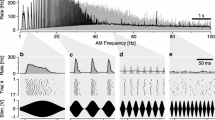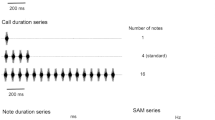Abstract
Wriggling call produced by mouse pups when struggling in the nest is one of the mouse early ontogenesis communicative vocalization. Processing of these signals by auditory midbrain and primary auditory cortex neurons with different response patterns was the subject of this study. Responses of single neurons evoked by wriggling call models and a series of models consisting of 4 stimuli with different interstimulus intervals (0–1000 ms) were recorded extracellularly. A third of central nucleus neurons in the inferior colliculus showed a spectral facilitation in responses to various two- and three-tone combinations of the wriggling call frequency components. About 80% of such combination-sensitive neurons had tonic characteristics of responses, i.e. tonic, phasic-tonic, pauser and long-latency discharges. A study of responses of central nucleus neurons to a series of wriggling call models showed that at short interstimulus intervals (0–50 ms) responses to the 2nd–4th signals in a series were completely suppressed or significantly decreased in two-thirds of the recorded neurons, i.e. there arose adaptation to a series of sounds. Such neurons had mainly phasic discharges. In a third of neurons, adaptation did not arise; these neurons were tonically discharging. All neurons in the primary auditory cortex (anterior and primary auditory fields) demonstrated adaptation in responses to a series of wriggling calls. Discharges of neurons were phasic.



Similar content being viewed by others
REFERENCES
Egorova, M.A., Temporal characteristics of single neuron evoked activity in the mouse auditory midbrain, Sens. Sist., 2008, vol. 22(3), pp. 203–213.
Egorova, M.A., Peculiarities of time patterns of discharges of single auditory neurons of mouse inferior colliculi, J. Evol. Biochem. Physiol., 2008, vol. 44(5): 637–641. doi: 10.1134/S0022093008050149
Ehret, G., The auditory midbrain, a “shunting yard” of acoustical information processing, The Central Auditory System, Ehret, G. and Romand, R., Eds., New York, Oxford, 1997, pp. 259–316.
Egorova, М.А., Frequency selectivity of neurons of the primary auditory field (A1) and anterior auditory field (AAF) in the auditory cortex of the house mouse (Mus musculus), J. Evol. Biochem. Physiol., 2005, vol. 41(4), pp. 476–480.
Egorova, M.A., Khorunzhii, G.D., and Akimov, A.G., The timescale of adaptation in tonal sequence processing by mouse primary auditory cortical neurons, J. Evol. Biochem. Physiol., 2019, vol. 55(6), pp. 497–501. doi: 10.1134/S0022093019060085
Joachimsthaler, B., Uhlmann, M., Miller, F., Ehret, G., and Kurt, S., Quantitative analysis of neuronal response properties in primary and higher-order auditory cortical fields of awake house mice (Mus musculus), Eur. J. Neurosci., 2014, vol. 39, pp. 904–918. doi: 10.1111/ejn.12478
Egorova, M.A. and Akimov, A.G., Acoustic characteristics in the low-frequency nest call of the house mouse (Mus musculus) early ontogenesis, Acoust. Physics, 2010, vol. 56(3), pp. 391–397. doi: 10.1134/S1063771010030152
Gaub, S. and Ehret, G., Grouping in auditory temporal perception and vocal production is mutually adapted: the case of wriggling calls of mice, J. Comp. Physiol., 2005, vol. 191, pp. 1131–1135. doi: 10.1007/s00359-005-0036-y
Egorova, M.A., Vartanian, I.A., and Ehret, G., Neurophysiological correlates of critical bands in the auditory midbrain, Sens. Sist., 2002, vol. 16(1), pp. 3–12.
Egorova, M., Ehret, G., Vartanian, I., and Esser, K.-H., Frequency response areas of neurons in the mouse inferior colliculus. I. Threshold and tuning characteristics, Exp. Brain Res., 2001, vol. 140, pp. 145–161. doi 10.1007/s002210100786
Sidman, R.L., Angevine, J.B., and Pierce, E.T., Atlas of the mouse brain and spinal cord, Boston, Harvard University Press, 1971.
Ehret, G. and Moffat, A.J., M. Inferior colliculus of the house mouse. II. Single unit responses to tones, noise and tone-noise combinations as a function of sound intensity, J. Comp. Physiol., 1985, vol. 156, pp. 619–635. doi:10.1007/BF00619112
Stiebler, I. and Ehret, G., Inferior colliculus of the house mouse. I. A quantitative study of tonotopic organization, frequency representation and tone-threshold distribution, J. Comp. Neurol., 1985, vol. 238, pp. 65–76. 1985. doi: 10.1002/cne.902380106
Romand, R. and Ehret, G., Development of tonotopy in the inferior colliculus. I. Electrophysiological mapping in house mice, Dev. Brain Res., 1990, vol. 54, pp. 221–234. doi: 10.1016/0165-3806(90)90145-O
Stiebler, I., Neulist, R., Fichtel, I., and Ehret, G., The auditory cortex of the house mouse: left-right differences, tonotopic organization and quantitative analysis of frequency representation, J. Comp. Physiol. A, 1997, vol. 181, pp. 559–571. doi: 10.1007/s003590050140
Suga, N., Auditory neuroethology and speech processing: complex-sound processing by combination-sensitive neurons, Auditory Function. The Neurobiological Bases of Hearing, Edelman, G.M., Gall, W.E., and Cowan, W.M., Eds., New York, 1988, pp. 679–720.
Portfors, C.V. and Sinex, D.G., Coding of communication sounds in the inferior colliculus, The Inferior Colliculus, Winer, J.A. and Schrei-ner, C.E., Eds., New York, 2005, pp. 411–425.
Egorova, M. and Ehret, G., Tonotopy and inhibition in the midbrain inferior colliculus shape spectral resolution of sounds in critical bands, Eur. J. of Neurosci., 2008, vol. 28, pp. 675–692. doi: 10.1111/j.1460-9568.2008.06376.x
Egorova, M.A. and Akimov, A.G., Spectral coding in auditory midbrain neurons, J. Integr. Neurosci., 2013, vol. 12(1), pp. 1–15. doi: 10.1142/S0219635213500027
Rhode, W.S., Oertel, D., and Smith, P.H., Physiological response properties of cells labeled intracellularly with horseradish peroxidase in cat ventral cochlear nucleus, J. Comp. Neurol., 1983, vol. 213(4), pp. 448–463. doi: 10.1002/cne.902130407
Golding, N.L., Robertson, D., and Oertel, D., Recordings from slices indicate that octopus cells of the cochlear nucleus detect coincident firing of auditory nerve fibers with temporal precision, J. Neurosci., 1995, vol. 15(4), pp. 3138–3153. doi: 10.1523/JNEUROSCI.15-04-03138.1995
Khorunzhii, G.D. and Egorova, M.A., Time characteristics of impulse activity of Neurons with the V-shaped frequency receptive fields in the house mouse (Mus musculus) auditory midbrain, J. Evol. Biochem. Physiol., 2014, vol. 50(4), pp. 357–361. doi: 10.1134/S0022093014040097
Funding
This work was supported by the Russian Foundation for Basic Research (projects no. 09-04-00656, 15-04-05234, 18-015-00188) and by the state budget for 2018–2020 (reg. no. АААА-А18-118013090245-6).
Author information
Authors and Affiliations
Contributions
M.A. Egorova was responsible for designing experiments, data collecting, data processing, writing and editing a manuscript. A.G. Akimov was in charge of designing experiments, data collecting and processing, writing and editing a manuscript.
Corresponding author
Ethics declarations
All applicable international, national and institutional principles of handling and using experimental animals for scientific purposes were observed. This study did not involve human subjects as research objects.
Rights and permissions
About this article
Cite this article
Egorova, M.A., Akimov, A.G. Specialization of Neurons with Different Response Patterns in the Mouse Mus musculus Auditory Midbrain and Primary Auditory Cortex during Communication Call Processing. J Evol Biochem Phys 56, 406–414 (2020). https://doi.org/10.1134/S0022093020050038
Received:
Revised:
Accepted:
Published:
Issue Date:
DOI: https://doi.org/10.1134/S0022093020050038




